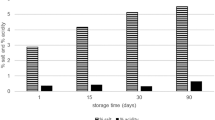Abstract
Physicochemical and microbial analyses were conducted for artisanal and semi-industrial manufacturing processes of the Cotija cheese. Differences between manufacturing processes in Cotija cheese affect the microbial composition in the final product. Lactic acid bacteria are important microorganisms in the artisanal Cotija cheese manufacturing. Thirty-one different microorganisms were isolated and identified by ribosomal sequencing analysis during the production of this artisanal cheese. The yeast isolates comprised the following species: Kluyveromyces lactis, Kluyveromyces marxianus, Pichia guillermondii, Rhodotorula mucilaginosa, Galactomyces reessii, and Galactomyces geotrichum. Bacterial isolates were members of the Lactobacillaceae family with the follow species: Pediococcus pentosaceus, Lactobacillus brevis, Lactobacillus plantarum, and Lactobacillus casei. The possible role of these microorganisms in the final flavor and taste, and their utility in the control of undesirable microorganisms in artisanal Cotija cheese is discussed.
Similar content being viewed by others
References
Poméon T. El queso Cotija, México (Cotija cheese in Mexico). FAO/IICA, San Salvador, México. p. 42 (2007)
Coppola R, Nanni M, Lorizzo M, Sorrentino A, Sorrentino E, Chiavari C, Grazia L. Microbiological characteristics of Parmigiano Reggiano cheese during the cheesemaking and the first months of the ripening. Lait 80: 479–490 (2000)
Corsetti A, Rossi J, Gobbetti M. Interactions between yeasts and bacteria in the smear surface-ripened cheeses. Int. J. Food Microbiol. 69: 1–10 (2001)
Brennan NM, Ward AC, Beresford TP, Fox PF, Goodfellow M, Cogan TM. Biodiversity of the bacterial flora on the surface of a smear cheese. Appl. Environ. Microb. 68: 820–830 (2002)
Coppola S, Blaiotta G, Ercolini D, Moschetti G. Molecular evaluation of microbial diversity occurring in different types of Mozzarella cheese. J. Appl. Microbiol. 90: 414–420 (2001)
AOAC. Official Method of Analysis of AOAC Intl. 15th ed. Methods 920.124, 926.08. Association of Official Analytical Chemists, Washington, DC, USA (1990)
Barnett JA, Payne RW, Yarrow D. Descriptions of the species, arranged alphabetically. pp. 79–695. In: Yeasts: Characteristics and Identification. Barnett JA, Payne RW, Yarrow D (eds). Cambridge Univ. Press, Cambridge, UK (1990)
Kandler O, Weiss N. Genus Lactobacillus Beijerinck 1901. Vol. 2, pp. 1209–1234. In: Bergey’s Manual of Systematic Bacteriology. Sneath PHA, Mair NS, Sharpe ME, Holt JG (eds). The Williams and Wilkins Co., Baltimore, VA, USA (1986)
NOM-155-SCFI-2003 Mexican Norm: milk, milk formula, and dairy products combined. Denomination, Physicochemical Specifications, Commercial Information and Test Methods, Mexico City, México. p. 46 (2003)
Rojas-Herrera R, Narváez-Zapata JA, Zamudio-Maya M, Mena-Martínez ME. A simple silica-based method for metagenomic DNA extraction from soil and sediments. Mol. Biotechnol. 40: 13–17 (2008)
Strom K, Sjogren J, Broberg A, Schnurer J. Lactobacillus plantarum MiLAB 393 produces the antifungal cyclic dipeptides Cyclo(l-Phe-l-Pro) and Cyclo(l-Phetrans-4-OH-l-Pro) and 3-phenyllactic acid. Appl. Environ. Microb. 68: 4322–4327 (2002)
White TJ, Bruns T, Lee S, Taylor J. Amplification and direct sequencing of fungal ribosomal RNA genes for phylogenetics. pp. 315–322. In: PCR Protocols. A Guide to Methods and Applications. Innis MA, Gelfand DH, Sninsky JJ, White TT (eds). Academic Press, San Diego, CA, USA (1990)
O’Donnell K. Fusarium and its near relatives. pp. 225–233. In: The Fungal Holomorph: Mitotic, Meiotic, and Pleomorphic Speciation in Fungal Systematic. Reynolds DR, Taylor JW (eds). CAB International, Wallingford, Oxon, UK (1993)
Welthagen JJ, Viljoen BC. The isolation and identification of yeasts obtained during the manufacture and ripening of Cheddar cheese. Food Microbiol. 16: 63–73 (1999)
Ferreira AD, Viljoen BC. Yeasts as adjunct starters in matured Cheddar cheese. Int. J. Food Microbiol. 86: 131–140 (2003)
Roostita R, Fleet GH. The occurrence and growth of yeast in Camembert and Blue veined cheeses. Int. J. Food Microbiol. 28: 393–404 (1996)
Eliskases-Lechner F, Ginzinger W. The yeast flora of surface-ripened cheeses. Milchwissenschaftliche 50: 458–462 (1995)
Fadda ME, Mossa V, Pisano MB, Depilano M, Cosentino S. Occurrence and characterization of yeasts isolated from artisanal Fiore Sardo cheese. Int. J. Food Microbiol. 95: 51–59 (2004)
Wyder MT, Puhan Z. Role of selected yeasts in cheese ripening: An evaluation in aseptic cheese curd slurries. Int. Dairy J. 9: 117–124 (1999)
Casalta E, Sorba JM, Aigle M, Ogier JC. Diversity and dynamics of the microbial community during the manufacture of Calenzana, an artisanal Corsican cheese. Int. J. Food Microbiol. 133: 243–251 (2009)
Randazzo CL, Torriani S, Akkermans ADL, de Vos WM, Vaughan EE. Diversity, dynamics, and activity of bacterial communities during production of an artisanal Sicilian cheese as evaluated by 16S rRNA analysis. Appl. Environ. Microb. 68: 1882–1892 (2002)
Martin-Platero AM, Valdivia E, Maqueda M, Martin-Sanchez I, Martinez-Bueno M. Polyphasic approach to bacterial dynamics during the ripening of Spanish farmhouse cheese, using culture-dependent and independent methods. Appl. Environ. Microb. 74: 5662–5673 (2008)
Di Cagno R, De Angelis M, Limitone A, Fox PF, Gobbetti M. Response of Lactobacillus helveticus PR4 to heat stress during propagation in cheese whey with a gradient of decreasing temperatures. Appl. Environ. Microb. 72: 4503–4514 (2006)
Bolm H, Morvedt C. Anti-microbial substances produced by food associated microorganisms. Biochem. Soc. T. 19: 694–698 (1991)
Piard JC, Desmazeaud MJ. Inhibiting factors produced by lactic acid bacteria. 2. Bacteriocins and other antimicrobial substances. Lait 72: 113–142 (1992)
Florez AB, Mayo B. Microbial diversity and succession during the manufacture and ripening of traditional, Spanish, blue-veined Cabrales cheese, as determined by PCR-DGGE. Int. J. Food Microbiol. 110: 165–171 (2006)
Bonetta S, Bonetta S, Carraro E, Rantsiou K, Cocolin L. Microbiological characterization of Robiola di Roccaverano cheese using PCR-DGGE. Food Microbiol. 25: 786–792 (2008)
De Angelis M, Corsetti A, Tost N, Rossi J, Corbo MR, Gobbetti M. Characterization of non-starter lactic acid bacteria from Italian Ewe cheeses based on phenotypic, genotypic, and cell wall protein analyses. Appl. Environ. Microb. 67: 2011–2020 (2001)
Dolci P, Alessandria V, Zeppa G, Rantsiou G, Cocolin L. Microbiological characterization of artisanal Raschera PDO cheese: Analysis of its indigenous lactic acid bacteria. Food Microbiol. 25: 392–399 (2008)
Author information
Authors and Affiliations
Corresponding author
Rights and permissions
About this article
Cite this article
Flores-Magallón, R., Oliva-Hernández, A.A. & Narváez-Zapata, J.A. Characterization of microbial traits involved with the elaboration of the Cotija cheese. Food Sci Biotechnol 20, 997–1003 (2011). https://doi.org/10.1007/s10068-011-0137-z
Received:
Revised:
Accepted:
Published:
Issue Date:
DOI: https://doi.org/10.1007/s10068-011-0137-z




